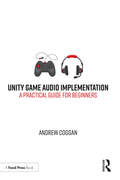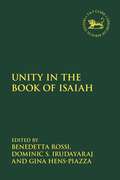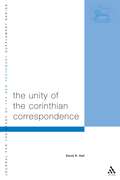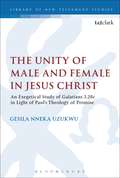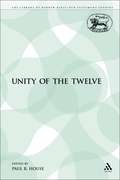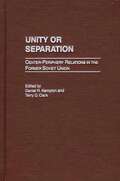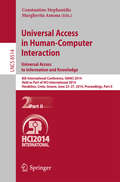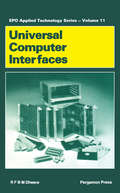- Table View
- List View
Unity from Diversity: Pluralist Systemic Thinking for Social and Behavioural Research
by Ray W. CookseyThis book is about the choices that researchers can make when building knowledge in social and behavioural spaces. Knowledge is the unity we seek and, given that social and behavioural research is a human endeavour focusing on human lives and experiences, there are diverse and ever-evolving pathways towards achieving that unity. Any one pathway will only ever yield partial glimpses into human life and diversity of potential choices serves to enrich, expand, and enlarge those glimpses in pursuit of more complete understanding. The book shows that researchers and the researched are far more connected than disconnected in this world and those connections are spread out through a network of interlinked complex systems. The book argues that pluralist systemic thinking provides the means by which a researcher’s methodological choices for navigating the ‘Data Triangle’ (comprising data source, data gathering, and data analysis strategies) and the learning they provide can be fully and robustly contextualised with respect to those systems and the expectations and influences that emerge from them. Such contextualisations facilitate the refinement, augmentation, and/or narrowing of those choices during the researcher’s journey. Anticipating choices downstream may have implications for more immediate choices and more immediate choices may create a cascade of necessary downstream choices. An essential part of contextualisation involves making choices about patterns of guiding assumptions, modes of knowledge building, and research frames. Researchers must develop the capacity to be flexible and adapt to unanticipated emergent events, obstacles, and political influences, making trade-offs where necessary throughout their research journey, always with an eye on both feasibility and quality. Importantly, research has no meaning unless the researcher can ensure that it connects with intended audiences via specific research outcomes, especially since the ultimate judgments about the convincingness, meaningfulness, quality, and utility of the research are vested in those audiences. Throughout the book, special attention is devoted to the role(s) that stakeholders and gatekeepers play in shaping the researcher’s journey as well as to what can be learned from Indigenous/First Nations perspectives on social and behavioural research.
Unity Game Audio Implementation: A Practical Guide for Beginners
by Andrew CogganUnity Game Audio Implementation offers a unique, practical, project-based approach to learning about aspects of Interactive Game Audio for those who have never used a game engine before and don’t want to learn computer programming right now. The book offers insight into the skills needed to design game-ready sounds in current Digital Audio Workstation (DAW) and shows how to implement these sounds within the Unity game engine. The reader will also learn about interactive music and how to set this up to respond to a variety of events in the game, with the option of adding in their own story and dialogue. All the information is presented in a practical working context from an established Game Audio Sound Designer with AAA games experience. The chapters are accompanied by several game levels teaching all about the techniques and theories before offering instructive steps for how to put them into action. After completing the practical tasks in this book, not only will the reader create an interactive soundscape for a multilevel playable game featuring all their own audio, they will also receive tips on how to use their finished project in support of an application for Video Game Sound Designer jobs.
Unity Game Audio Implementation: A Practical Guide for Beginners
by Andrew CogganUnity Game Audio Implementation offers a unique, practical, project-based approach to learning about aspects of Interactive Game Audio for those who have never used a game engine before and don’t want to learn computer programming right now. The book offers insight into the skills needed to design game-ready sounds in current Digital Audio Workstation (DAW) and shows how to implement these sounds within the Unity game engine. The reader will also learn about interactive music and how to set this up to respond to a variety of events in the game, with the option of adding in their own story and dialogue. All the information is presented in a practical working context from an established Game Audio Sound Designer with AAA games experience. The chapters are accompanied by several game levels teaching all about the techniques and theories before offering instructive steps for how to put them into action. After completing the practical tasks in this book, not only will the reader create an interactive soundscape for a multilevel playable game featuring all their own audio, they will also receive tips on how to use their finished project in support of an application for Video Game Sound Designer jobs.
Unity in Diversity: Achieving Structural Race Equity in Schools
by Rachel MacfarlaneA third of all children in our schools are from racially minoritised backgrounds. Yet the data on attainment, exclusion, progression and representation indicates that our education system is structurally racist. Unity in Diversity explores the unconscious biases at play in our schools and demonstrates how educators can address this by improving representation in the curriculum, staffroom and on the governing/trust board. Drawing on case studies from leaders, this book demonstrates what schools are already doing to create an impactful anti-racist ethos and how these strategies may be applied in practice. Written by an experienced headteacher who has supported a diverse range of schools in improving their race equity, each chapter addresses a different aspect of race inequality and provides practical strategies for overcoming it. This book empowers readers: To acknowledge that systemic race inequality exists in schools and that this necessitates an anti-racist approach To become comfortable talking about race and to create safe spaces for staff and students to engage in discussions about race To address unconscious biases and white fragility and to examine the inequality and underrepresentation of ethnic groups To audit all aspects of educational provision to determine what needs to change and to action and implement this change with lasting impact. Schools and teachers can play a major role in eliminating systemic racism in society. This book is an essential read for any teacher, leader, governor or trustee who is restless to address race inequity in our education system, creating a more equal and represented school community.
Unity in Diversity: Achieving Structural Race Equity in Schools
by Rachel MacfarlaneA third of all children in our schools are from racially minoritised backgrounds. Yet the data on attainment, exclusion, progression and representation indicates that our education system is structurally racist. Unity in Diversity explores the unconscious biases at play in our schools and demonstrates how educators can address this by improving representation in the curriculum, staffroom and on the governing/trust board. Drawing on case studies from leaders, this book demonstrates what schools are already doing to create an impactful anti-racist ethos and how these strategies may be applied in practice. Written by an experienced headteacher who has supported a diverse range of schools in improving their race equity, each chapter addresses a different aspect of race inequality and provides practical strategies for overcoming it. This book empowers readers: To acknowledge that systemic race inequality exists in schools and that this necessitates an anti-racist approach To become comfortable talking about race and to create safe spaces for staff and students to engage in discussions about race To address unconscious biases and white fragility and to examine the inequality and underrepresentation of ethnic groups To audit all aspects of educational provision to determine what needs to change and to action and implement this change with lasting impact. Schools and teachers can play a major role in eliminating systemic racism in society. This book is an essential read for any teacher, leader, governor or trustee who is restless to address race inequity in our education system, creating a more equal and represented school community.
Unity in the Book of Isaiah (The Library of Hebrew Bible/Old Testament Studies)
Building on previous holistic readings of the Book of Isaiah, this collection approaches Isaiah through the concept of unity. Contributors outline research that point to new directions in the unity movement and, in the process, bring it under a critical gaze, considering the perennial challenges to unity reading and thus problematizing the very concept of unity.Divided into four parts, the book provides methodological reflections on reading Isaiah as a unity, and examines historical and redactional readings, literary readings and contextual or reader-orientated readings. Topics include how the figure of Jacob functions as a unifying motif in the final form of the book, Isaiah 1 as an example of the relevance of local structure for global coherence and how woman as a root metaphor of Zion not only bears revelatory significance but also serves as a theological linchpin for a more holistic reading of the book. Overall, the book highlights the continued promise of holistic readings for diverse methods and varied approaches to the Book of Isaiah.
Unity of Corinthian Correspondence: Unity Of The Corinthian Correspondence (The Library of New Testament Studies #251)
by David R. HallThe thesis of this book is that 1 and 2 Corinthians are closely related; that Paul faces the same opponents in both letters; that the letter written with many tears referred to in 2 Corinthians is 1 Corinthians; and that there is no need to posit an intermediate visit or letter between the two canonical letters. Throughout the two letters Paul implements a consistent pastoral strategy, and an understanding of this strategy explains the difference in tone between various sections of the two letters. There is no need for theories of partition.
The Unity of Male and Female in Jesus Christ: An Exegetical Study of Galatians 3.28c in Light of Paul's Theology of Promise (The Library of New Testament Studies)
by Gesila Nneka UzukwuThis detailed exegetical study of Gal 3.28c in the light of 3.14-29 and 4.21-31 shows not only how integral this verse is to chapters 3 and 4 of the letter, but also that it is the key to understanding Paul's theological argument of promise in Galatians. Paul's use of the story of Abraham in 3.14-29 and of Sarah in 4.21-31 in light of God's promise to the patriarch and the matriarch in Genesis 17 have implications displays the joint role of Abraham and Sarah in bringing about the promise, and underscores the unity of the believers in Christ. In light of this, Uzukwu examines important aspects of the history of the interpretation of Gal 3.28c. Uzukwu sheds light on the link between Gal 3:28 and the three expressions of gratitude found in Greek writings. Links are also revealed to the three blessings of gratitude that appear at the beginning of the Jewish cycle of morning prayers, Gen 1.27c (in the Septuagint), and the alleged pre-Pauline baptismal formula. She goes further to demonstrate how 3.28c is related to the unity of Galatians 3-4, focusing on the theme of the promise as the text discusses the effect of the Christ event in bringing about the fulfillment of that promise.
The Unity of the Twelve (The Library of Hebrew Bible/Old Testament Studies)
by Paul R. HouseScholars have long noted the consistent canonical ordering of the minor prophets, yet have not located their unity. In this instructive book Paul House presents a close reading that demonstrates the Twelve's cohering principles. Both literary criticism and the minor prophets are succinctly introduced here. Biblical theology is also furthered through the study's focus on unity.
Unity or Separation: Center-Periphery Relations in the Former Soviet Union
by Daniel R. Kempton Terry D. ClarkMany analysts initially believed that the process of Soviet disintegration would inevitably open a Pandora's box of ethnic nationalism and regional self-determination. But, despite obvious setbacks such as Chechnya, the developments of the last decade have shown that while forces of disintegration remain a very real threat, the fifteen successor states have managed to stay largely intact. One explanation for this somewhat unexpected success is the varied strategies of center-periphery relations adopted by the post-Soviet states, tailored to meet the unique of circumstances faced by each former republic of the Soviet Union. The contributors to this up-to-date volume examine the specific cases of success and failure in center-periphery relations in the former USSR, and offer some provocative overall conclusions about the progress made and the impact on the process of democratization.The cases examined in this volume are drawn from Russia, Lithuania, Ukraine, Uzbekistan, among others. These case studies demonstrate that realtions between national and local governments have been evolving differently in each of the successor states in the but in each case there has been a conscious attempt to create stacble center-periphery relations, which give a degree of autonomy to minority groups while still providing for a stable state and democratic development. This book will be of interest to scholars and students of the former Soviet Union and those interested in federalization and center-periphery.
Universal Access in Human-Computer Interaction: 8th International Conference, UAHCI 2014, Held as Part of HCI International 2014, Heraklion, Crete, Greece, June 22-27, 2014, Proceedings, Part II (Lecture Notes in Computer Science #8514)
by Constantine Stephanidis Margherita AntonaThe four-volume set LNCS 8513-8516 constitutes the refereed proceedings of the 8th International Conference on Universal Access in Human-Computer Interaction, UAHCI 2014, held as part of the 16th International Conference on Human-Computer Interaction, HCII 2014, held in Heraklion, Crete, Greece in June 2014, jointly with 14 other thematically similar conferences.The total of 1476 papers and 220 posters presented at the HCII 2014 conferences was carefully reviewed and selected from 4766 submissions. These papers address the latest research and development efforts and highlight the human aspects of design and use of computing systems. The papers thoroughly cover the entire field of human-computer interaction, addressing major advances in knowledge and effective use of computers in a variety of application areas. The total of 251 contributions included in the UAHCI proceedings were carefully reviewed and selected for inclusion in this four-volume set. The 65 papers included in this volume are organized in the following topical sections: access to mobile interaction; access to text, documents and media; access to education and learning; access to games and ludic engagement and access to culture.
Universal Access in Human-Computer Interaction. Access to Media, Learning and Assistive Environments: 15th International Conference, UAHCI 2021, Held as Part of the 23rd HCI International Conference, HCII 2021, Virtual Event, July 24–29, 2021, Proceedings, Part II (Lecture Notes in Computer Science #12769)
by Margherita Antona Constantine StephanidisThis two-volume set constitutes the proceedings of the 15th International Conference on Universal Access in Human-Computer Interaction, UAHCI 2021, held as part of the 23rd International Conference, HCI International 2021, held as a virtual event, in July 2021. The total of 1276 papers and 241 posters included in the 36 HCII 2021 proceedings volumes was carefully reviewed and selected from 5222 submissions. UAHCI 2021 includes a total of 84 regular papers; they focus on topics related to universal access methods, techniques and practices, studies on accessibility, design for all, usability, UX and technology acceptance, emotion and behavior recognition for universal access, accessible media, access to learning and education, as well universal access to virtual and intelligent assistive environments.
Universal Access in Human-Computer Interaction. Theory, Methods and Tools: 13th International Conference, UAHCI 2019, Held as Part of the 21st HCI International Conference, HCII 2019, Orlando, FL, USA, July 26–31, 2019, Proceedings, Part I (Lecture Notes in Computer Science #11572)
by Margherita Antona Constantine StephanidisThis two-volume set constitutes the proceedings of the 13th International Conference on Universal Access in Human-Computer Interaction, UAHCI 2019, held as part of the 21st International Conference, HCI International 2019, which took place in Orlando, FL, USA, in July 2019. The total of 1274 papers and 209 posters included in the 35 HCII 2019 proceedings volumes was carefully reviewed and selected from 5029 submissions. UAHCI 2019 includes a total of 95 regular papers; they were organized in topical sections named: universal access theory, methods and tools; novel approaches to accessibility; universal access to learning and education; virtual and augmented reality in universal access; cognitive and learning disabilities; multimodal interaction; and assistive environments.
Universal Access in Human-Computer Interaction. User and Context Diversity: 16th International Conference, UAHCI 2022, Held as Part of the 24th HCI International Conference, HCII 2022, Virtual Event, June 26 – July 1, 2022, Proceedings, Part II (Lecture Notes in Computer Science #13309)
by Margherita Antona Constantine StephanidisThis two-volume set constitutes the refereed proceedings of the 16th International Conference on Universal Access in Human-Computer Interaction, UAHCI 2022, held as part of the 24th International Conference, HCI International 2022, held as a virtual event, in June-July 2022. A total of 1271 papers and 275 posters included in the 39 HCII 2022 proceedings volumes. UAHCI 2022 includes a total of 73 papers; they focus on topics related to universal access methods, techniques and practices, studies on accessibility, design for all, usability, UX and technology acceptance, emotion and behavior recognition for universal access, accessible media, access to learning and education, as well universal access to virtual and intelligent assistive environments.
Universal Access Through Inclusive Instructional Design: International Perspectives on UDL
by Susie L. Gronseth Elizabeth M. DaltonUniversal Access Through Inclusive Instructional Design explores the ways that educators around the world reduce barriers for students with disabilities and other challenges by planning and implementing accessible, equitable, high-quality curricula. Incorporating key frameworks such as Universal Design for Learning, these dynamic contributions highlight essential supports for flexibility in student engagement, representation of content, and learner action and expression. This comprehensive resource—rich with coverage of foundations, policies, technology applications, accessibility challenges, case studies, and more—leads the way to design and delivery of instruction that meets the needs of learners in varying contexts, from early childhood through adulthood.
Universal Access Through Inclusive Instructional Design: International Perspectives on UDL
by Susie L. Gronseth Elizabeth M. DaltonUniversal Access Through Inclusive Instructional Design explores the ways that educators around the world reduce barriers for students with disabilities and other challenges by planning and implementing accessible, equitable, high-quality curricula. Incorporating key frameworks such as Universal Design for Learning, these dynamic contributions highlight essential supports for flexibility in student engagement, representation of content, and learner action and expression. This comprehensive resource—rich with coverage of foundations, policies, technology applications, accessibility challenges, case studies, and more—leads the way to design and delivery of instruction that meets the needs of learners in varying contexts, from early childhood through adulthood.
Universal Approaches to Support Children’s Physical and Cognitive Development in the Early Years
by Sue Soan Eve HuttonThis book has been designed to provide educators with practical strategies and approaches to support the motor and coordination development of children within an educational setting. Difficulties with movement and coordination can significantly affect participation and learning, in Early Years settings and schools, but many of these children can be supported through changes to their educational environment, or the implementation of universal strategies. This invaluable resource demonstrates how professionals can positively impact on children’s educational progress, outcomes and social participation. This book: Combines perspectives of occupational therapy and special educational needs, using evidence-based research to provide professionals with the knowledge and confidence to enhance quality first teaching skills for all children, in all settings. Promotes inclusion and participation in activities that affect pupil progress, such as handwriting, self-care, lunchtime, physical activities and play. Offers a range of activities, tips and guidance to help improve progress and academic achievement for all children. Taking a holistic approach to early learning and teaching, this is a vital resource for teachers and trainee teachers, teaching assistants, SENCOs, student occupational therapists and all practitioners working in Early Years settings.
Universal Approaches to Support Children’s Physical and Cognitive Development in the Early Years
by Sue Soan Eve HuttonThis book has been designed to provide educators with practical strategies and approaches to support the motor and coordination development of children within an educational setting. Difficulties with movement and coordination can significantly affect participation and learning, in Early Years settings and schools, but many of these children can be supported through changes to their educational environment, or the implementation of universal strategies. This invaluable resource demonstrates how professionals can positively impact on children’s educational progress, outcomes and social participation. This book: Combines perspectives of occupational therapy and special educational needs, using evidence-based research to provide professionals with the knowledge and confidence to enhance quality first teaching skills for all children, in all settings. Promotes inclusion and participation in activities that affect pupil progress, such as handwriting, self-care, lunchtime, physical activities and play. Offers a range of activities, tips and guidance to help improve progress and academic achievement for all children. Taking a holistic approach to early learning and teaching, this is a vital resource for teachers and trainee teachers, teaching assistants, SENCOs, student occupational therapists and all practitioners working in Early Years settings.
Universal Computer Interfaces (ISSN #Volume 11)
by R.F.B.M. DheerePresents a survey of the latest developments in the field of the universal computer interface, resulting from a study of the world patent literature. Illustrating the state of the art today, the book ranges from basic interface structure, through parameters and common characteristics, to the most important industrial bus realizations. Recent technical enhancements are also included, with special emphasis devoted to the universal interface adapter circuit. Comprehensively indexed.
Universal Design for Learning in the Early Childhood Classroom: Teaching Children of all Languages, Cultures, and Abilities, Birth – 8 Years
by Pamela Brillante Karen NemethUniversal Design for Learning in the Early Childhood Classroom focuses on proactively designing PreK through Grade 3 classroom environments, instruction, and assessments that are flexible enough to ensure that teachers can accommodate the needs of all the students in their classrooms. Typically developing students, gifted students, students who are impacted by poverty, children who speak multiple languages or have a home language that is different than the classroom language, and students with identified or potential developmental or learning disabilities are all covered within this highly practical, easy-to-use guide to UDL in the early years.
Universal Design for Learning in the Early Childhood Classroom: Teaching Children of all Languages, Cultures, and Abilities, Birth – 8 Years
by Pamela Brillante Karen NemethUniversal Design for Learning in the Early Childhood Classroom focuses on proactively designing PreK through Grade 3 classroom environments, instruction, and assessments that are flexible enough to ensure that teachers can accommodate the needs of all the students in their classrooms. Typically developing students, gifted students, students who are impacted by poverty, children who speak multiple languages or have a home language that is different than the classroom language, and students with identified or potential developmental or learning disabilities are all covered within this highly practical, easy-to-use guide to UDL in the early years.
Universal Design for Learning in the Early Childhood Classroom: Teaching Children of all Languages, Cultures, and Abilities, Birth – 8 Years
by Pamela Brillante Karen NemethUniversal Design for Learning in the Early Childhood Classroom, Second Edition focuses on proactively designing PreK through Grade 3 classroom instruction, environments, and assessments that are flexible enough to ensure that teachers can accommodate the needs of all the students in their classrooms. Featuring updated language and examples to elevate discussions about inclusion and access along with a stronger anti-bias focus, this second edition includes new content on trauma-informed practice, strength-based approaches, social-emotional learning, family partnerships, and using remote and virtual technology. Highly practical and easy to use, this book remains THE essential guide to UDL in the early years.
Universal Design for Learning in the Early Childhood Classroom: Teaching Children of all Languages, Cultures, and Abilities, Birth – 8 Years
by Pamela Brillante Karen NemethUniversal Design for Learning in the Early Childhood Classroom, Second Edition focuses on proactively designing PreK through Grade 3 classroom instruction, environments, and assessments that are flexible enough to ensure that teachers can accommodate the needs of all the students in their classrooms. Featuring updated language and examples to elevate discussions about inclusion and access along with a stronger anti-bias focus, this second edition includes new content on trauma-informed practice, strength-based approaches, social-emotional learning, family partnerships, and using remote and virtual technology. Highly practical and easy to use, this book remains THE essential guide to UDL in the early years.
Universal Grammar and the Second Language Classroom (Educational Linguistics #16)
by Melinda Whong, Kook-Hee Gil and Heather MarsdenThis book proposes that research into generative second language acquisition (GenSLA) can be applied to the language classroom. Assuming that Universal Grammar plays a role in second language development, it explores generalisations from GenSLA research. The book aims to build bridges between the fields of generative second language acquisition, applied linguistics, and language teaching; and it shows how GenSLA is poised to engage with researchers of second language learning outside the generative paradigm. Each chapter of Universal Grammar and the Second Language Classroom showcases ways in which GenSLA research can inform language pedagogy. Some chapters include classroom research that tests the effectiveness of teaching particular linguistic phenomena. Others review existing research findings, discussing how these findings are useful for language pedagogy. All chapters show how generative linguistics can enhance teachers’ expertise in language and second language development. “This groundbreaking volume ably takes on the gap that currently exists between generative linguistic theory in second language acquisition (GenSLA) and second language pedagogy, by gathering chapters from GenSLA researchers who are interested in the relevance and potential application of their research to second/foreign language teaching. It offers a welcome and thought-provoking contribution to any discussion of the relation between linguistic theory and practice. I recommend it not only for language teachers interested in deepening their understanding of the formal properties of the languages they teach, but also for linguists interested in following up on more practical consequences of the fruits of their theoretical and empirical research.” Donna Lardiere, Georgetown University, Washington DC, USA
The Universal Right to Education: Justification, Definition, and Guidelines (Sociocultural, Political, and Historical Studies in Education)
by Joel SpringIn this book, Joel Spring offers a powerful and closely reasoned justification and definition for the universal right to education--applicable to all cultures--as provided for in Article 26 of the United Nation's Universal Declaration of Human Rights. One sixth of the world's population, nearly 855 million people, are functionally illiterate, and 130 million children in developing countries are without access to basic education. Spring argues that in our crowded global economy, educational deprivation has dire consequences for human welfare. Such deprivation diminishes political power. Education is essential for providing citizens with the tools for resisting totalitarian and repressive governments and economic exploitation. What is to be done? The historically grounded, highly original analysis and proposals Spring sets forth in this book go a long way toward answering this urgent question. Spring first looks at the debates leading up to the Universal Declaration of Human Rights in 1948, to see how the various writers dealt with the issue of cultural differences. These discussions provide a framework for examining the problem of reconciling cultural differences with universal concepts. He next expands on the issue of education and cultural differences by proposing a justification for education that is applicable to indigenous peoples and minority cultures and languages. This justification is then applied to all people within the current global economy. Acknowledging that the right to an education is inseparable from children's rights, he uses the concept of a universal right to education to justify children's rights, and, in turn, applies his definition of children's liberty rights to the concept of education. His synthesis of cultural, language, and children's rights provides the basis for a universal justification and definition for the right to education -- which, in the concluding chapters, Spring uses to propose universal guidelines for human rights education, and instruction in literacy, numeracy, cultural centeredness, and moral economy.

